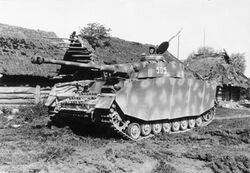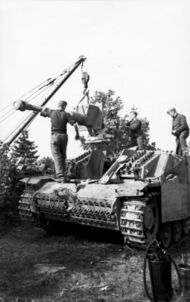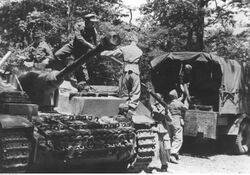Engineering:7.5 cm KwK 40
| 7,5 cm KwK 40 (L/48) | |
|---|---|
 7.5 cm KwK 40 L/48 on a Panzer IV ausf. H | |
| Type | Tank gun |
| Place of origin | Germany |
| Service history | |
| Used by | Germany |
| Wars | World War II |
| Production history | |
| Designer | Rheinmetall-Borsig AG |
| Manufacturer | Rheinmetall-Borsig AG |
| Unit cost | 13500 RM |
| Produced | 1942-45 |
| Specifications | |
| Mass | 750 kg (1,650 lb) |
| Barrel length | 361.5 cm (11 ft 10.3 in) bore (48 calibers) |
| Shell | Fixed QF 75×495mm R |
| Calibre | 75 mm (2.95 in) |
| Elevation | -10° to +20° |
| Rate of fire | 10–15 round per minute |
| Muzzle velocity | 750 m/s (2,500 ft/s) |
| Maximum firing range | 7,700 m (8,400 yd) |
The 7.5 cm KwK 40 (7.5 cm Kampfwagenkanone[lower-alpha 1] 40) was a German 75 mm Second World War era vehicle-mounted gun, used as the primary armament of the German Panzer IV (F2 model onwards) medium tank and the Sturmgeschütz III (F model onwards) and Sturmgeschütz IV assault guns which were used as tank destroyers.
The design of the KwK 40 was adapted from the similar towed anti-tank gun, the 7.5 cm Pak 40. It replaced the short-barrel 7.5 cm KwK 37 a 24-calibre long close-support gun, providing a huge improvement in firepower for mid-war tank designs. It came in two versions, 43 ("L/43") and 48 ("L/48") calibres long barrels, the former used during 1942 and early 1943, and the latter after that point. Along with the Pak 40, the KwK 40/StuK 40 was the most numerous anti-tank gun of the German army, and remained an effective weapon until the war's end.
History
When mounted on a casemate-armored assault gun-designated vehicle (Sturmgeschütz)) instead of a turreted tank, the weapon was called Sturmkanone 40 (StuK 40). Both the KwK 40 and StuK 40 were developed from the towed 7.5 cm Pak 40 anti-tank gun. The length of the ammunition used was shortened to allow for easier storage of said ammunition in vehicles the KwK 40 and StuK 40 would be mounted on.
The KwK 40 L/43 was mounted on the Panzer IV from April 1942 until June 1943. All 225 vehicles of the Panzer IV F2 mounted the L/43 with a ball shaped muzzle brake. About a 1,000 out of the 1,687 vehicles of the Panzer IV Ausf. G mounted the L/43 with a double baffle muzzle brake. The StuG III with the L/43 gun was designated as Ausf. F. of which only 120 were equipped with the L/43 (the remaining 246 having the longer L/48 version). All StuG III production runs through Ausf. F/8 to G mounted the longer L/48. The 780 original Jagdpanzer IV tank destroyers mounted the Pak 39 variant of the L/48 gun, the later Panzer IV/70 mounted the even longer Panther-derived StuK 42 L/70.
The L/48 was 334 mm (13.1 inches) longer and slightly more powerful than the L/43. L/48 became the standard gun from June 1942 until the end of World War II. The gun was fitted with an electric firing mechanism and the breech operated semi-automatically. Only one-piece ammunition was used.
- Following number of vehicles mounted L/48 version from June 1942-April 1945
- Approximately 6,000 vehicles of Ausf. G, H, J out of 8,800 Panzer IV
- 7,720 vehicles of StuG III Ausf. G + 246 of Ausf.F + 250 vehicles of StuG III Ausf. F/8
- All 1,139 vehicles of StuG IV
- 780 Jagdpanzer IV
As with the 7.5 cm Pak 40, the muzzle brake of the KwK 40 and StuK 40 went through a series of design changes. Five types of muzzle brakes were used, gradually increasing the area of exposure to the blast. The designs progressed from tubular type double baffle muzzle brakes to single baffle ball shape muzzle brakes, which proved to be insufficient in reducing recoil, followed by a double flange type from May 1943. The front flange and rear disk type was used from March 1944, followed finally by the double disc type.
Ammunition
KwK 40 used shell 75×495 mm R [1][2][3]
- Pzgr. Patr. 39 KwK 40 (Armour Piercing Capped Ballistic Cap (APCBC) High Explosive round)
- Muzzle velocity: 750 m/s (2,500 ft/s)
- Projectile: Panzergranate 39 (Pzgr. 39)
- Projectile weight: 6.8 kg (15 lb)
- Explosive filler: 18 g (0.63 oz) of RDX/wax
- Fuze: BdZ 5103 or BdZ 5103* base fuze
- Round weight: 11.52 kg (25.4 lb)
- Cartridge case height: 495 mm (19.5 in)
- Propelling charge: 2.41 kg (5.3 lb) of Digl. R.P. G1
- Primer: electric, model C/22 or C/22 St.
- Pzgr. Patr. 40 KwK 40 (Armour Piercing Composite Rigid)
- Muzzle velocity: 930 m/s (3,100 ft/s)
- Projectile: Panzergranate 40
- Projectile weight: 4.1 kg (9.0 lb)
- Explosive filler: none
- Fuze: none
- Round weight: 8.61 kg (19.0 lb)
- Cartridge case height: 495 mm
- Propelling charge: 2.2 kg (4.9 lb) of Gu. R.P. 7,7
- Primer: electric, model C/22 or C/22 St.
- Gr. Patr. 38 HL/B KwK 40 (High-explosive anti-tank)
- Muzzle velocity: 450 m/s (1,500 ft/s)
- Projectile: Gr. 38 HL/B
- Projectile weight: 5 kg (11 lb)
- Explosive filler: 0.51 kg (1.1 lb) of RDX/wax
- Fuze: A.Z. 38 St
- Round weight: 7.36 kg (16.2 lb)
- Cartridge case height: 495 mm
- Propelling charge: 0.43 kg (0.95 lb) of Gu. Bl. P.-AO
- Primer: electric, model C/22 or C/22 St.
- Gr. Patr. 38 HL/C KwK 40 (High Explosive Anti-Tank)
- 7.5 cm Sprgr.Patr.34 KwK 40 (High Explosive) L/48
- Muzzle velocity: 550 m/s (1,800 ft/s)
- Projectile: Sprgr. 34
- Projectile weight: 5.75 kg (12.7 lb)
- Explosive filler: 0.66 kg (1.5 lb) of amatol (2760 Kilojoules)
- Fuze: kl. A.Z. 23 (0,15) umg. nose fuze
- Round weight: 8.71 kg (19.2 lb)
- Cartridge case height: 495 mm
- Propelling charge: 0.755 kg (1.66 lb) of Gu. Bl. P.-AO
- Primer: electric, model C/22 or C/22 St.
Penetration comparison
| Gun type | Barrel length | Ammunition type | Muzzle velocity | Penetration | ||||
|---|---|---|---|---|---|---|---|---|
| 100 m (330 ft) | 500 m (1,600 ft) | 1,000 m (3,300 ft) | 1,500 m (4,900 ft) | 2,000 m (6,600 ft) | ||||
| 7.5 cm KwK 37 L/24 | 1,762.5 mm (69.39 in) | K.Gr.Patr.rot.Pz | 385 m/s (1,260 ft/s) | 41 mm (1.6 in) | 39 mm (1.5 in) | 35 mm (1.4 in) | 33 mm (1.3 in) | 30 mm (1.2 in) |
| 7.5 cm StuK 40 L/43 | 3,281 mm (129.2 in) | Pzgr.Ptr.39 | 740 m/s (2,400 ft/s) | 99 mm (3.9 in) | 91 mm (3.6 in) | 82 mm (3.2 in) | 72 mm (2.8 in) | 63 mm (2.5 in) |
| 7.5 cm KwK 40 L/48 | 3,615 mm (142.3 in) | Pzgr.Ptr.39 | 750 m/s (2,500 ft/s) | 110 mm (4.3 in) | 97 mm (3.8 in) | 86 mm (3.4 in) | 75 mm (3.0 in) | 64 mm (2.5 in) |
| 7.5 cm KwK 40 L/48 | 3,615 mm (142.3 in) | Pzgr.Ptr.40 | 930 m/s (3,100 ft/s) | 143 mm (5.6 in) | 120 mm (4.7 in) | 97 mm (3.8 in) | 77 mm (3.0 in) | |
| Gun type | Ammunition type | Muzzle velocity | Penetration | ||||||||||
|---|---|---|---|---|---|---|---|---|---|---|---|---|---|
| 100 m | 250 m (820 ft) | 500 m | 750 m (2,460 ft) | 1000 m | 1,250 m (4,100 ft) | 1500 m | 2000 m | 2,500 m (8,200 ft) | 3,000 m (9,800 ft) | ||||
| 7.5 cm StuK 40 L/43 | APCBC | 740 m/s (2,400 ft/s) | 133 mm (5.2 in) | 128 mm (5.0 in) | 121 mm (4.8 in) | 114 mm (4.5 in) | 107 mm (4.2 in) | 101 mm (4.0 in) | 95 mm (3.7 in) | 85 mm | 75 mm (3.0 in) | 67 mm (2.6 in) | |
| 7.5 cm StuK 40 L/43 | APCR | 920 m/s (3,000 ft/s) | 173 mm (6.8 in) | 164 mm (6.5 in) | 151 mm (5.9 in) | 139 mm (5.5 in) | 127 mm (5.0 in) | 117 mm (4.6 in) | 108 mm (4.3 in) | 91 mm (3.6 in) | 77 mm | 65 mm (2.6 in) | |
| 7.5 cm KwK 40 L/48 | APCBC | 750 m/s | 135 mm (5.3 in) | 130 mm (5.1 in) | 123 mm (4.8 in) | 116 mm (4.6 in) | 109 mm (4.3 in) | 103 mm (4.1 in) | 97 mm | 86 mm (3.4 in) | 76 mm (3.0 in) | 68 mm (2.7 in) | |
| 7.5 cm KwK 40 L/48 | APCR | 930 m/s | 176 mm (6.9 in) | 167 mm (6.6 in) | 154 mm (6.1 in) | 141 mm (5.6 in) | 130 mm | 119 mm (4.7 in) | 109 mm | 92 mm (3.6 in) | 78 mm (3.1 in) | 66 mm (2.6 in) | |
Usage of KwK or Pak/StuK variant
L/43
- Panzer IV Ausf. F2/G
- Sturmgeschütz III Ausf. F StuK 40
L/48
- Panzer IV IV Ausf. G (Late production G's.)
- Panzer IV Ausf. H/J
- Sturmgeschütz III Ausf. F/8 and G StuK 40
- Jagdpanzer IV Pak 39
- Sturmgeschütz IV StuK 40
See also
- Ordnance QF 75 mm
- F-34 tank gun
- 75 mm Gun M2/M3/M6
- 7.5 cm Pak 39
Notes
- ↑ "fighting vehicle gun"
References
- ↑ "75-77 Mm Calibre Cartridges". http://www.quarryhs.co.uk/ammotable8.html.
- ↑ "7,5 cm Kw K 40 (L/48)". Panzer World. 18 November 2013. https://panzerworld.com/7-5-cm-kw-k-40-l-48.
- ↑ "German Explosive Ordnance". Departments of the Army and the Air Force. 16 March 1953. pp. 397–402. https://apps.dtic.mil/dtic/tr/fulltext/u2/a376695.pdf.
- ↑ Sturmgeschutz & Its Variants, Walter J. Spielberger, P67, ISBN:0-88740-398-0
- ↑ Bird, Lorrin Rexford; Livingston, Robert D. (2001). WWII Ballistics: Armor and Gunnery. Overmatch Press. p. 61.
External links
 |



